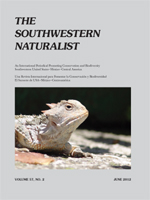Comparisons of assemblages of rodents along the Rio Grande in Big Bend National Park, Brewster County, Texas, were made using recent (2009–2010) and historic (1977) data to evaluate the effects of invasion by saltcedars (Tamarix). Comparisons of abundances and species of rodents between sites with mesquites (Prosopis), cottonwoods (Populus), or saltcedars revealed no significant difference between habitats. Comparisons of recent and historic assemblages of rodents suggested low turnover of species, but structure of assemblages differed between studies. The western harvest mouse (Reithrodontomys megalotis) was an addition to the riparian fauna and neither the silky pocket mouse (Perognathus flavus) nor Nelson's pocket mouse (Chaetodipus nelsoni) was captured during the recent assessment. Differences in assemblages may be caused by shifts in riparian plants toward a more closed canopy or by recolonization following flooding.
Comunidades de roedores a lo largo del río Grande en el Parque Nacional Big Bend, condado de Brewster, Texas, fueron comparadas usando registros recientes (2009–2010) e históricos (1977) para evaluar los efectos de la especie invasora tamarisco (Tamarix). Comparaciones de las especies y abundancias de roedores en lugares con mezquites (Prosopis), álamos (Populus) y tamariscos no revelaron diferencias significativas entre estos hábitats. Comparaciones de los registros recientes y de los históricos, sugirieron baja tasa de cambio de especies, pero la estructura de estas comunidades varió entre los estudios. El ratón cosechero común (Reithrodontomys megalotis) fue un nuevo registro para la fauna rivereña, y ni el ratón de abazones sedosos (Perognathus flavus) ni la rata de abazones de Nelson (Chaetodipus nelsoni) fueron capturados durante el muestreo reciente. Diferencias en la estructura de estas comunidades son posiblemente causadas por los cambios en la vegetación rivereña la cual tiende a un tipo de bosque más cerrado o la recolonización después de inundaciones.





